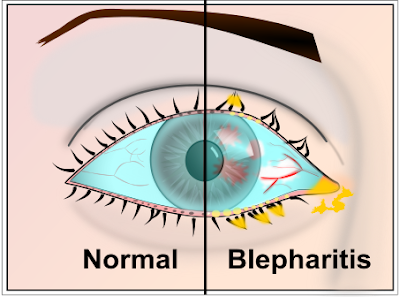Blepharitis is the medical term for inflamed eyelids.
You may notice tired, or gritty eyes, which may be uncomfortable in sunlight or a smoky atmosphere. They may be slightly red, and feel as though there is something in them.
What is the cause of blepharitis?
The eyelids have tiny glands in them, especially the lower lids. These glands make lipids that provide a protective oil coating over the tear film and helps stop the tears from breaking up.
As you get older, and particularly if you have dry skin, these glands can block. Without the substance that makes the tears spread, the tears break up, and dry patches develop. These patches make the eyes feel sore or gritty.
Aims of blepharitis treatment:
- to unblock the glands in the eyelid, which may be infected and inflamed, like acne on the face or a tiny boil.
- to replace tears if the eyes are dry.
The treatment will your eyes more comfortable, but there is no magic cure and it may return once treatment is ceased. Even with treatment your eyes may remain a little sore, but no harm will come to them and there is nothing to worry about. It's not a serious condition, and there is rarely any damage to your eyes.
1 Lid Cleaning
Soak some cotton wool in warm water. Rub the cotton wool over the closed eyelids for 2-3 minutes, and repeat. Then clean the edge of the lower eyelid with a cotton bud to remove scales and debris on the edge of the eyelid. Move the cotton bud along the eyelid, using a mirror, and pulling the lid away from the eyeball with the fingers of the other hand. Rub the edge of the lid gently. The warm bathing helps to soften up the scales first. It is preferable to boil the water first to sterilise it, and allow it to cool. It may be two weeks for any improvement. Bathe 2-3 times a day, gradually reducing the frequency of bathing as the eyes become more comfortable (although bathing does not help everyone). It is safe to stop cleaning, but you may need to start again if the condition returns. There is a number of dedicated lid hygiene wipes and cleaners such as “Supranettes”, “Lidcare” and “Ocusoft Lid Cleaning Foam.” These are embedded with special cleaning agents which specifically target the secretions produced by blepharitis. Ask at the reception desk for details.
2 Lubricants
Lubricants can helpful to both assist the spread of your own tears and lubricate the eye, and replace tears if you have ‘dry eyes’. We recommend sodium hyaluronate based products as they help restore healthy conjunctiva helping treat dry eye. Drops such as ‘Systane’ or 'Blink Intensive Eye Drops' may help. Gels such as ‘Celluvisc’ or ‘Viscotears’ are usually helpful. Lipid replacement sprays, such as actimist, in some cases can help.
3 Warm Compresses
The lipids produced by the glands in the lids tend to be liquid at body temperature (36 degrees C). As the lids are exposed they tend to be a bit cooler and the lipids solidify. This leads to the lipids not spreading so well blocking the glands and allowing bacteria to inhabit the lash margins and glands. The bacteria can then release endotoxins into the the tears which can make the eyes feel uncomfortable, itchy and burning. Warm compresses will increase the temperature of the lipids to flow more like a liquid which will help unblock the glands.
4 Antibiotic ointment/Antibiotic tablets
If the cleaning is not helpful, an antibiotic ointment may be required from your GP. Try it for 3 months (chloramphenicol or fucithalmic). As the condition can return once treatments are stopped, you may need a repeat prescription from your GP. In severe blepharitis, antibiotic tablets may be an option, especially if associated with skin condition, such as acne rosacea, or very dry skin, or if the edge of your eyelid stays red with many scales. Antibiotic tablets are NOT suitable for everyone, particularly if you use several other tablets or have stomach problems. You will need to discuss this treatment with your GP first. Oxytetracycline 250mg twice daily (or doxcycline 50mg once daily [or erythromycin]) is usually used for 3 months. The benefit lasts several months after this treatment, but you may need to use further lid hygiene to stop recurrence.
Other causes of sore eyes
If you continue to have symptoms we recommend that you have your eyes assessed. You may have dry eyes (or at least poorly spreading tears) and replacement tears may help, as described. You may have an allergy, particularly if the eyes are itchy: Optichrom or another anti-allergy drop could help with these symptoms. You can see your GP on the NHS or alternatively, you can book in for a private Dry Eye Assessment with your Optometrist. Your eyes should be checked routinely by an optometrist for other conditions such as glaucoma; occasionally new spectacles may make the eyes more comfortable. If your eyes remain red and very irritable we can now offer DRY EYE ASSESSMENTS for £35.00 which can investigate the causes. Alternatively you can see your GP for NHS treatment.
Recommended Products
Comfort Drops
Artificial tears makes your eyes feel better
Heat mask
Lid Wipes
Cleans lid crusting
INTRODUCING BLEPHEX
Until recently Blepharitis was very hard to manage. Now there is the BlephEx. The First and Only Clinician Treatment for Blepharitis, is now available at Mellis Eyecare
BlephEx™ is a revolutionary new patented hand piece, used to very precisely and carefully, spin a medical grade micro-sponge along the edge of your eyelids and lashes, removing scurf and debris and exfoliating your eyelids.
Initial assessment and treatment is £40.00













